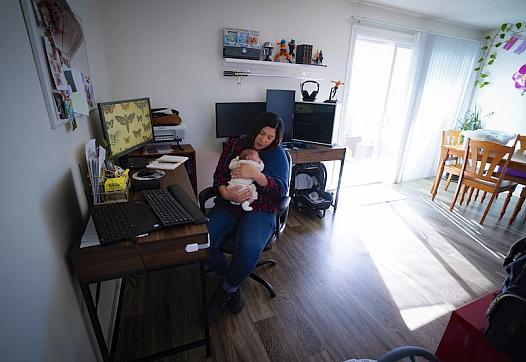California’s child care aid misses hundreds of thousands of families who need it
This story was originally published in The San Diego Union-Tribune with support from the 2022 National Fellowship.
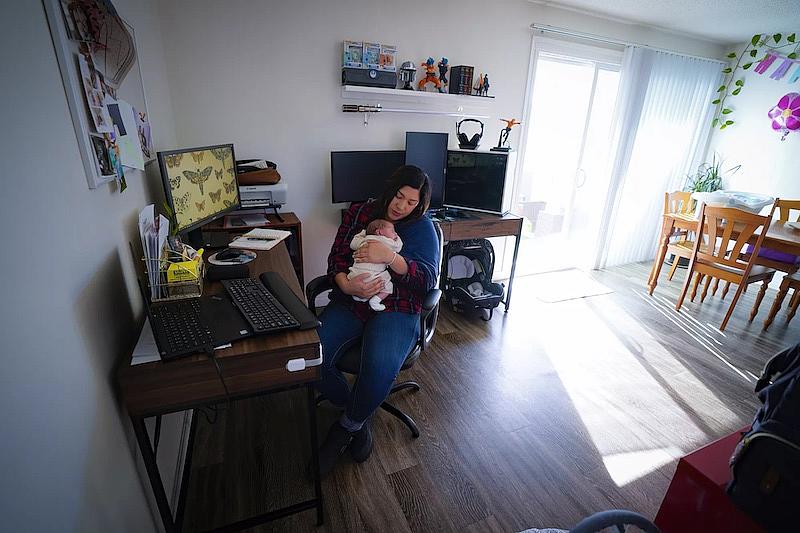
Zaira Reynoso juggles caring for her 2-week-old baby, Ander, and checking email at her home in Chula Vista. Reynoso, who works from home as a coach to family child care providers, spends a lot of the day in online meetings and answering emails, and because of the cost of day care, she is caring for her newborn while she works.(Nelvin C. Cepeda / The San Diego Union-Tribune)
Nelvin C. Cepeda
Zaira Reynoso wanted to give her daughter, Ania, a sibling. But one fear was holding the 31-year-old and her husband Erik back from pursuing another pregnancy: They couldn’t afford child care for another kid.
It’s already hard for the Reynosos to afford the $635 a month they pay for Ania’s part-time preschool at Southwestern College.
On top of the $750 a month they pay out of pocket for health insurance, the rent for their 800-square-foot apartment in Chula Vista just went up by $200, to $2,200 a month. Virtually everything the couple makes goes straight to bills, Reynoso said.
If the Reynosos wanted to add child care for a baby into the mix, it would likely cost approximately $1,500 a month — the market average for infant care in San Diego County.
And that’s assuming they could even find an available child care spot for the baby amid a severe shortage of infant spaces.
Still, the couple decided to have a baby and make it work. Zaira Reynoso gave birth to a boy, Ander, at the end of November.
Reynoso can’t afford child care, but she can’t afford to quit her job — she is a coach to local child care providers — to become a full-time parent, either. Neither can her husband, who works long hours for a medical imaging company and doesn’t have as flexible a work schedule as she does. So she is taking care of her newborn herself while working from home full-time.

Reynoso is terrified, she said. She had tried the same thing with Ania and ended up crying herself to sleep many nights, feeling like she was failing at both her job and being a good mom.
“Adding the stress of having to work and take care of your child, it’s really scary,” Reynoso said. “You have your child whom you love with all your life, and feeling that mom guilt because you’re not providing to your child the attention that they should have, especially a baby.”
‘Still just a drop in the bucket’
Child care is an essential service that the economy depends on — without it, parents can’t work. Care and education for children in their earliest years is crucial to raising a healthy generation, providing social and emotional nurturing at arguably the most developmentally important time of children’s lives.
But families, providers and experts have long warned that the child care industry nationwide is in crisis.
In most cases, neither public subsidies nor tuition paid by families are enough to cover child care programs’ costs. Despite state help, providers and their employees suffer from razor-thin profit margins and low pay — perpetually struggling to make ends meet, much less to serve more children.
At the same time, the price of child care still far surpasses what most families can afford. The average U.S. family with at least one child under 5 years old must spend 13 percent of its income for child care, the U.S. Treasury Department estimated in a 2021 report.
Child care in America, the agency declared, is “a classic market failure.”
In California, education and care aren’t a given until children are old enough to enter the state’s public school system, which starts serving children at age 4 in transitional kindergarten. Until then, families are largely on their own in finding and paying for child care.
There is help for families in paying for child care, made possible by a decades-old federal law that helps fund subsidized child care programs in all 50 states.
Today, California primarily pays for child care in two ways: It directly pays agencies, ranging from private providers to school districts, to offer subsidized child care and preschool to income-eligible families. It also gives income-eligible families vouchers they can use to pay for care.
These programs are the only statewide help California families have in paying for child care.
But even in one of the country’s most progressive states, that system of support for years has been serving only a small fraction of families and has been missing hundreds of thousands of children who need it, an analysis of California subsidy data and interviews with more than a dozen families, providers and experts show.
The income limits to qualify for subsidized child care are so low that most young children can’t access it. Fewer than 40 percent of California children under 4 years old met the criteria to get it in 2020, according to an analysis of the latest estimates available from the American Institutes of Research Early Learning Needs Assessment Tool.
That has left many families like the Reynosos falling into a gap: They make too much to qualify for help but too little to afford care.

Making little enough to qualify is no guarantee of help, either. Most of the families who do qualify are not getting served.
Just 17 percent of California children under the age of 4 whose families met the income limits and needed subsidized care actually got it in 2020, according to the Early Learning Needs Assessment Tool — down from the less than the 22 percent who both qualified and received it in 2018.
In the end, California’s system of child care support reaches only a limited number of families, serving just 6 percent of the state’s children under 4 in 2020, data from the Early Learning Needs Assessment Tool show.
That’s partly because California has never paid enough to serve them all.
In recent years, the state has made new efforts to serve more young children.
Gov. Gavin Newsom and other state leaders have pursued transitional kindergarten, a new grade level they are rolling out for all 4-year-olds, as their primary early childhood strategy.
The grade — which can be offered only by school districts, not child care providers — is expected to be available to all families by the 2025-2026 school year and to serve 450,000 children, a spokesperson for Newsom said in an email.
In 2021, Newsom and other state leaders also announced a plan to pay for 200,000 new subsidized child care spaces by 2026, calling it an unprecedented investment that would lift up women and working families.
But those new spaces represent just a third of the nearly 600,000 children under 4 who qualified for subsidized care but did not receive it in 2020, according to the Early Learning Needs Assessment Tool.
“We’ve definitely seen that increase — but you know, when you put it in context of the number of children that are eligible, it’s still just a drop in the bucket,” said Mary Ignatius, statewide organizer for advocacy group Parent Voices. “We’re talking about a system that has been underfunded for decades.”
That is forcing parents — especially women, who are more likely than men to handle child care — to make personal, work and even health sacrifices to fill in the gap.
For some, parents told The San Diego Union-Tribune, that has meant forgoing wages, skipping medical appointments, taking on second jobs, and even abandoning careers.
Child care vs. career
Amanda Buzzell doesn’t qualify for state help paying for child care. But between working as an after-school arts program director at the Boys & Girls Club and raising three kids, she still couldn’t make child care work for her family.
After calling providers near their home in Point Loma, she found that she and her husband would have had to pay as much as $800 a month for after-school care for their two older children and as much as $3,000 a month for care their 1-year-old daughter — that is, if they could find a place with an open infant care spot.
She also would have had to figure out how to drop off and pick up all three children, who would attend different schools, while commuting 45 minutes each way to her job in Carmel Valley.
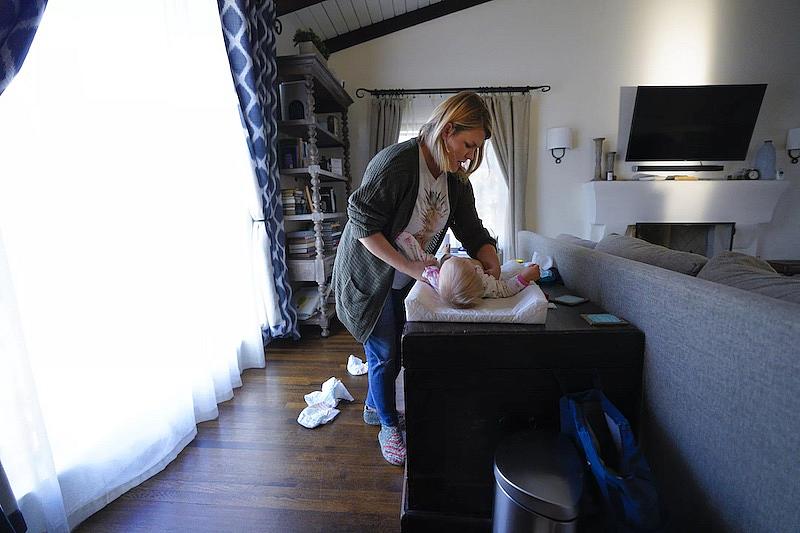
She could find only one solution: to quit her job and become a stay-at-home mom. So she did.
Buzzell’s husband’s income is enough to sustain the whole family, she said. Now, it costs them the same for her not to work and instead to hire a part-time nanny at $350 a week as it would have cost to pay for care for all three children.
“On paper, our income level says we can pay for it. But when it was comparing my salary to what the child care was going to cost, it just wasn’t worth it,” Buzzell said.
Buzzell doesn’t know when she will be able to work again. And when she can, she wonders if the right job opportunity will be there.
She said she’s lucky that her family’s finances afford her the option to stay at home.
“But at the same time, it also makes you feel like your career and all the work that you’ve done and all of your ambitions — everything — are insignificant in a way. They’re not necessary to keep our family moving,” Buzzell said. “My ambitions and career path and passions, you know, those are important to keep me going.”
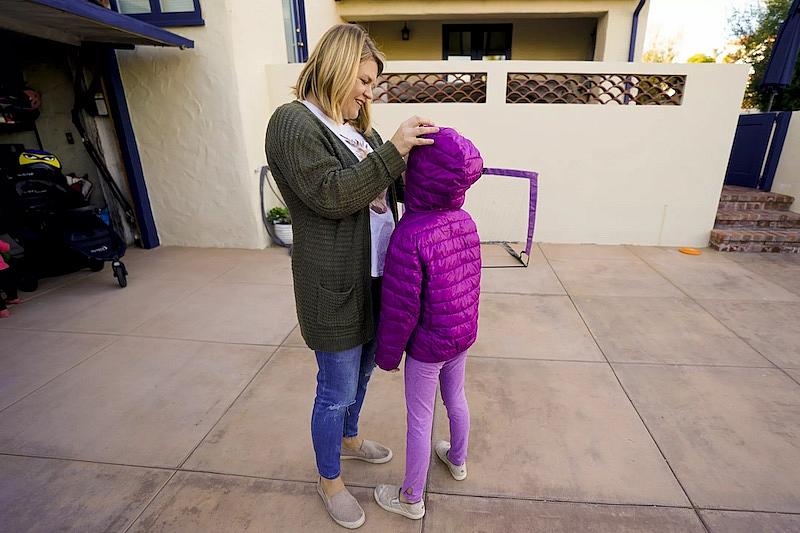
‘You start feeling like you’re choking’
In California, if a family makes the minimum required to make ends meet, they already make too much to qualify for subsidized child care.
In all 58 counties, the income that a family of two parents and two children needs to earn in order to afford basic living expenses is higher than the income limit to qualify for help paying for child care, according to a Union-Tribune analysis of data from the Massachusetts Institute of Technology’s Living Wage Calculator, which estimates the cost of living in each county.
To qualify for subsidized care, families need to make no more than 85 percent of the state median income. For a family of four in the current fiscal year, that means they need to make less than $95,289 annually.
Because that number is the same for every county, it can be particularly hard to qualify in large cities where costs of living are higher. In 2022, the gap between the income needed to qualify for help and the income needed to make ends meet was as wide as $32,000 for Los Angeles County, $33,000 for San Diego County and $72,000 for San Francisco.
The state recently expanded access by raising the income limits to 100 percent of the state median income for one early learning program — state-funded preschool, which serves 3- and 4-year-olds. But state preschool provides limited help with child care for many working parents because most enrollment spots are part-time, as little as three hours a day.
The income limits would have risen more dramatically under President Joe Biden’s Build Back Better Act, which died in the Senate in 2021.
The roughly $2 trillion legislation would have opened access to subsidized care for families making up to 250 percent of their state’s median income and capped their child care costs at 7 percent of their income. It also would have funded free preschool for all 3- and 4-year-olds.
While the legislation had limits — states could choose not to participate, and federal funding for the programs would have lasted only until 2027 — its failure disappointed child care advocates.
“It was a BFD,” said Ignatius, of Parent Voices, using the acronym for an expletive-containing expression for a significant event. “It was going to be our BFD moment, and we lost it by one senator.”
For the Reynosos, such legislation could have been the difference between affordable child care for their newborn and Zaira’s current juggling act.
Together, she and her husband take in about $110,000 a year before taxes.
That’s nearly four times the income limit for a family of four to get free child care paid by the federal government under the Head Start program. And it’s $14,700 over the income limit for state-subsidized child care.
The Reynosos have considered ways they might make ends meet: Should she get a second job on the weekends? Should they forfeit health insurance? Could she return to her lower-paying job with the Navy, just because the Navy offers discounted child care?
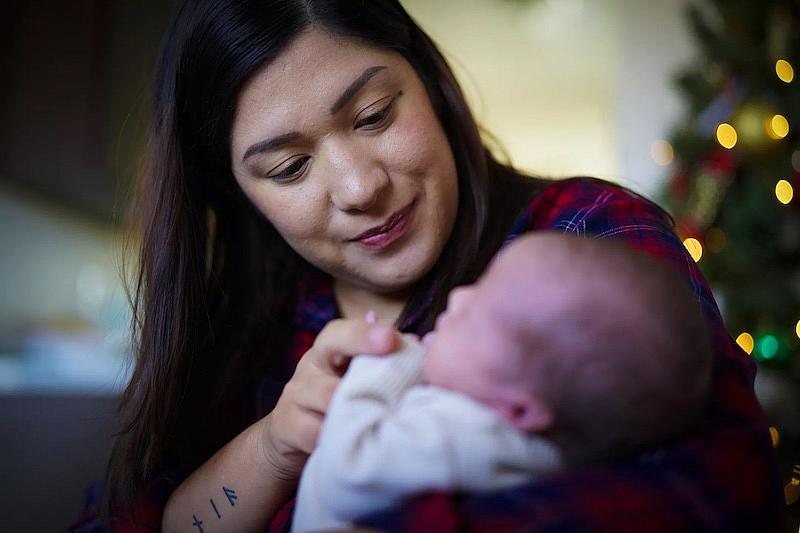
Reynoso is frustrated. She feels like she did everything she was supposed to: She worked herself out of an impoverished childhood, when she bounced between her parents’ places in Tijuana and Chula Vista and couldn’t afford school uniforms or sports shoes.
She worked minimum-wage jobs while getting her associate degree in early childhood education at Southwestern College, then earned a bachelor’s and became an early childhood teacher.
And for two years she and her husband lived in Tijuana, crossing the border early each morning for work, until they could afford to rent in California.
So why, she wonders, can she still barely make ends meet?
“You start feeling like you’re choking,” Reynoso said. “Being able to qualify for programs or at least a discount … for affordable, good-quality child care — that would make all the difference.”
When qualifying isn’t enough
Even when families do qualify for subsidized child care, there’s often no guarantee they will actually get it.
Perla Elkins said her family’s income is low enough to qualify for help paying for child care for their 2-year-old, Luciana, and their 1-year-old, Ozzie. But the Lakeside family still pays for child care by themselves.
Elkins takes home about $1,400 a month after taxes as a part-time clerk at the state Attorney General’s Office in downtown San Diego. Most of her take-home pay goes straight to Luciana’s preschool, Lakeside Presbyterian — $900 a month for four days a week.
“My job is paying for day care just so I can work to pay for day care,” she said.
By the time she’s made her $400 car payment and spent the usual $350 a month on gas for her family, Elkins’ paycheck is more than used up.
Meanwhile, her husband Aaron’s job working in shipping and receiving for a car company is just enough to pay for groceries and other bills, she said.
There’s no room in the family’s budget to pay for child care for Ozzie. The rates they have seen for infant care centers ranged from $1,000 a month for part-time care to $1,400 for full-time. So they and Aaron’s family — including his grandmother, his mom, his aunt and his uncle — take turns watching Ozzie.
“I feel really just mostly bad for the family,” Perla Elkins said. “I know it’s a lot of work to care for a kid that’s not yours for eight hours a day.”
She said she and her husband together make no more than $5,000 pre-tax each month — well below the $7,941 monthly income limit for qualifying for subsidized care.
She applied for subsidized care in July. But six months later, she said she hasn’t gotten a response.
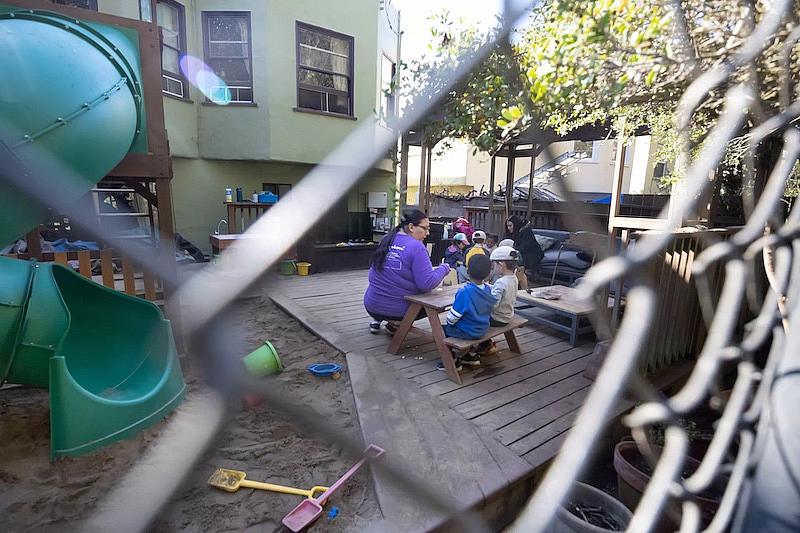
Just because a family makes it onto the child care subsidy list doesn’t guarantee they will get one.
“It will continue to be like that until the state decides to fund every eligible parent for subsidized child care, which would be a terrific thing for San Diego families,” said Rick Richardson, president and CEO of Child Development Associates, a San Diego-based agency that administers subsidized child care programs.
Child care resource and referral agencies in roughly a dozen California counties told the Union-Tribune last fall that the recent influx of child care funding from the state had allowed them to clear their eligibility lists — lists of income-eligible families who have applied for subsidized care — for the first time in recent memory.
But soon after they did, thousands of new families filled the lists again.
When there’s an eligibility list for a child care subsidy, families who have the lowest incomes and biggest family sizes get priority. Families like Elkins’, who have incomes in the higher range of eligibility, are less likely to get one.
Experts say that’s why the vast majority of children who end up receiving subsidized child care through the state social services department come from very low-income families — 86 percent are from families that make less than $48,000 a year, according to data obtained from the department.
“A family can be on the waiting list for a long time and never get in because their income will never qualify, even though they’re on the low-income part of the scale,” said Cristina Alvarado, executive director of Child Care Alliance Los Angeles, an organization of 10 child care referral agencies in Los Angeles County.
Since the income eligibility limits are so low, some parents have passed up job promotions because they couldn’t afford to lose their child care support, Alvarado and other child care agency officials said.
“If you’re making minimum wage, it probably costs less for you to stay home and not work than go out and pay for child care,” said Robin Layton, past president and CEO of Educational Enrichment Systems in San Diego.
For some parents, the wait comes with costs.

Vicky Hernandez said she waited on the eligibility list for almost a year until she finally secured a subsidized spot at a South Bay child care center. During that time, she gave up hours of work cleaning houses to care for her son.
Itzel Gonzalez said she got subsidized care for two of her children after years on the eligibility list. Now she’s waiting, again, for care for her infant daughter.
The San Diego single mom recently had surgery on her leg, and she’s supposed to be following it with rehabilitation therapy sessions — but with nobody to watch her baby, she’s been skipping them. Now she isn’t recovering properly, and her leg has weakened, she said.
It’s not just a lack of funding keeping some eligibility lists long, agencies said.
Bureaucracy often delays care from getting to families, who have to provide extensive paperwork to prove that they need child care — including documentation of all income, from wages to child support to alimony, as well as proof of their marital status, employment and who lives in their home.
“It is not a parent-friendly system,” said Kim McDougal, executive director of the YMCA of San Diego County Childcare Resource Service. “We’ve had people say it’s not worth it.”
Subsidizing the subsidy system
Once a family gets through the bureaucracy and secures a subsidy, they still have to find somewhere to use it — which child care experts say presents a whole other challenge.
There are more than three times as many children age 5 and under as there are licensed child care spaces for children that age in California, according to census estimates and data from the California Child Care Resource and Referral Network. The shortage is especially acute for infants and toddlers.
If a family manages to qualify for a subsidy, secure one and find a place to use it, there’s one more hurdle they must clear: They have to be able to pay for their subsidized child care.
The state does not cover the full cost of subsidized child care, so both families and child care providers fill in the gap by chipping in their own money — a phenomenon providers refer to as “subsidizing the subsidy system.”
Families generally must pay monthly fees based on an income-based sliding scale from $71 to $595 for full-time care. Federal law requires that states create a sliding fee scale for families to pitch in for the cost of subsidized child care.
Some California families don’t have to pay fees, including families enrolled in CalWORKS and families making less than 40 percent of the state median income — that is, less than $3,737 a month for a family of four.
But with those few exceptions, if a family can’t pay their fee, they lose their child care.
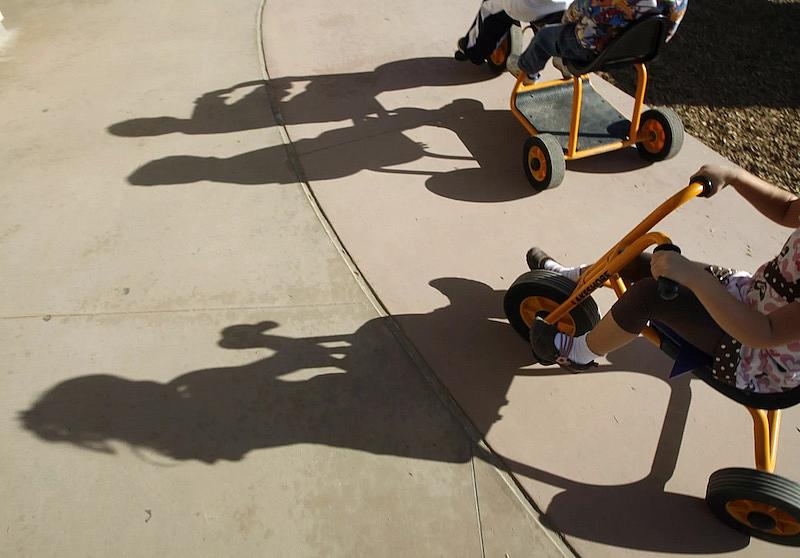
For the past two years, California has used one-time COVID-19 relief funds to waive those fees for families.
More than 26,000 families were believed to have benefited last fiscal year, according to data obtained from the state. About $88 million in family fees were waived this year.
But the fees are set to return starting July 1, after Newsom vetoed a bill last year that would have abolished fees for families who make below 75 percent of the state median income and capped fees at no more than 1 percent of a family’s monthly income. The bill had “yes” votes from all but one lawmaker.
In a letter to the Assembly explaining his veto, Newsom said although expanding access to early learning and care is a priority, he wasn’t willing to cover the cost of the fees permanently. “With our state facing lower-than-expected revenues over the first few months of this fiscal year, it is important to remain disciplined when it comes to spending, particularly spending that is ongoing,” he wrote.
The veto drew disappointment from child care advocates who call the fees a discriminatory policy that hurts poor families of color — almost three-quarters of families who receive subsidized child care are Latino or Black.
Parent Voices and other child care advocates have called for permanently eliminating family fees, expanding subsidized child care slots to cover everybody eligible and ensuring child care workers are paid enough to make a living wage.
“Low-income parents of color who qualify for subsidized child care have been subsidizing it with fees they can’t afford,” said Ignatius, of Parent Voices. “It could be as low as ($71) — but if you’re living paycheck to paycheck, that’s everything.”


